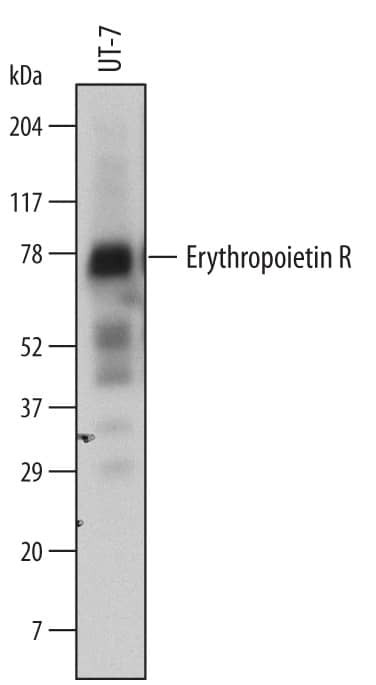Human Erythropoietin R Antibody
R&D Systems, part of Bio-Techne | Catalog # AF-322-PB

Key Product Details
Species Reactivity
Validated:
Cited:
Applications
Validated:
Cited:
Label
Antibody Source
Product Specifications
Immunogen
Pro26-Pro250
Accession # P19235
Specificity
Clonality
Host
Isotype
Scientific Data Images for Human Erythropoietin R Antibody
Detection of Human Erythropoietin R by Western Blot.
Western blot shows lysates of UT-7 human acute myeloid leukemia cell line. PVDF membrane was probed with 1 µg/mL of Goat Anti-Human Erythropoietin R Antigen Affinity-purified Polyclonal Antibody (Catalog # AF-322-PB) followed by HRP-conjugated Anti-Goat IgG Secondary Antibody (Catalog # HAF109). Specific bands were detected for Erythropoietin R at approximately 70-78 kDa (as indicated). This experiment was conducted under reducing conditions and using Immunoblot Buffer Group 1.Detection of Human Erythropoietin R by Simple WesternTM.
Simple Western lane view shows lysates of UT-7 human acute myeloid leukemia cell line, loaded at 0.2 mg/mL. A specific band was detected for Erythropoietin R at approximately 76 kDa (as indicated) using 10 µg/mL of Goat Anti-Human Erythropoietin R Antigen Affinity-purified Polyclonal Antibody (Catalog # AF-322-PB) followed by 1:50 dilution of HRP-conjugated Anti-Goat IgG Secondary Antibody (Catalog # HAF109). This experiment was conducted under reducing conditions and using the 12-230 kDa separation system.Applications for Human Erythropoietin R Antibody
Simple Western
Sample: UT‑7 human acute myeloid leukemia cell line
Western Blot
Sample: UT‑7 human acute myeloid leukemia cell line
Formulation, Preparation, and Storage
Purification
Reconstitution
Formulation
Shipping
Stability & Storage
- 12 months from date of receipt, -20 to -70 °C as supplied.
- 1 month, 2 to 8 °C under sterile conditions after reconstitution.
- 6 months, -20 to -70 °C under sterile conditions after reconstitution.
Background: Erythropoietin R
Erythropoietin (Epo), a glycoprotein produced primarily by the kidney, is the principal factor that regulates erythropoiesis by stimulating the proliferation and differentiation of erythroid progenitor cells. The biological effects of Epo are mediated by the erythropoietin receptor (Epo R). The genes for human and mouse Epo R have been cloned and characterized. The full-length human Epo R cDNA encodes a type I membrane-spanning protein with 508 amino acid (aa) residues (a 24 aa residue hydrophobic signal sequence, a 226 aa residue extracellular domain, a 22 aa residue transmembrane domain and a 236 aa residue cytoplasmic domain). At the protein sequence level, the human Epo R is approximately 82% identical to the mouse protein. As a result of alternative splicing of the Epo R gene, cDNA clones encoding a truncated form of the Epo R as well as the soluble form of Epo R has been found. The presence of a soluble form of the Epo R has also been detected on human sera. Recombinant soluble Epo R binds Epo with high affinity and is a potent Epo antagonist.
References
- Barber, D.L. and A.D. D’Andrea (1992) Seminars in Hematology 29:293.
- Youssoufian, H. et al. (1993) Blood 9:2223.
- Lodish, H.F. et al. (1995) Cold Spring Harbor Symposia on Quantitative Biology LX:93.
- Baynes, R.D. et al. (1993) Blood 82:2088.
Long Name
Alternate Names
Gene Symbol
UniProt
Additional Erythropoietin R Products
Product Documents for Human Erythropoietin R Antibody
Product Specific Notices for Human Erythropoietin R Antibody
For research use only

